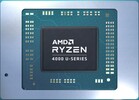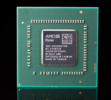AMD Ryzen 7 4700U vs AMD Ryzen 5 7520U vs AMD Ryzen 3 4300U
AMD Ryzen 7 4700U
► remove from comparison
The AMD Ryzen 7 4700U is a processor for thin and light laptops based on the Renoir architecture. The 4700U integrates all eight cores based on the Zen 2 microarchitecture. They are clocked at 2 (guaranteed base clock) to 4.1 GHz (Turbo). There is no support for the thread-doubling SMT tech. The chip is manufactured on the modern 7 nm TSMC process and partly thanks to it AMD advertises a 2x improved performance per Watt for the Renoir chips. Compared to the faster R7 4800U, the 4700U offers slightly lower clock speeds and no support for SMT / Hyperthreading.
In addition to the eight CPU cores, the APU also integrates a Radeon RX Vega 7 integrated graphics card with 7 CUs and up to 1600 MHz. The dual channel memory controller supports DDR4-3200 and energy efficient LPDDR4-4266 RAM. Furthermore, 8 MB level 3 cache can be found on the chip. See our hub page on the Renoir Processors for more information.
Performance
The average 4700U in our database proves to be a rather competent little processor. It trades blows with the much more power-hungry Intel Core i7-10750H, as far as multi-thread benchmark scores are concerned. While it fails to get far enough away from the more affordable Ryzen 5 4600U, this Ryzen 7 is still a good CPU for most tasks.
Your mileage may vary depending on how competent the cooling solution of your laptop is and how high the CPU power limits are.
Power consumption
The Ryzen 7 4700U is a 15 W chip. However, laptop makers are allowed to change that value to anything between 10 W and 25 W, with clock speeds and long-term performance changing accordingly as a result. By going for the lowest value, it is possible to build a passively cooled system around the APU.
The fairly modern 7 nm TSMC process this Ryzen is manufactured on makes for above average, as of mid 2022, energy efficiency.
AMD Ryzen 5 7520U
► remove from comparison
The AMD Ryzen 5 7520U is a mobile processor for cheap laptops of the Mendocino series. It integrates four older Zen 2 cores (similar to the Ryzen 4000 series like the Ryzen 3 4300U). The CPU cores clock from 2.8 GHz (base) to 4.3 GHz (single core Turbo) and can use 4 MB L3 cache. Thanks to SMT/Hyperthreading, the CPU can work on 8 threads simultaneously. The integrated memory controller only supports fast LPDDR5 memory (5500 MHz max.).
The integrated graphics adapter (Radeon 610M iGPU) uses the modern RDNA 2 architecture, but only 2 CUs (128 shaders) and clocks with up to 1.9 GHz.
Performance
The average 7520U in our extensive database is in the same league as the Core i7-1185G7, as far as multi-thread benchmark scores are concerned. This is a so-so result and indicative of a lower mid-range chip, as of Q3 2023.
Your mileage may vary depending on how high the CPU power limits are and how competent the cooling solution of your system is.
Mendocino series chips are produced on a relatively modern 6nm FinFET process at TSMC and should offer a good power efficiency. The R5 7520U is rated at 8-15 W TDP and therefore well suited for thin and light laptops.
AMD Ryzen 3 4300U
► remove from comparison
The AMD Ryzen 3 4300U is a processor for thin and light laptops based on the Renoir family. The 4300U integrates four cores based on the Zen 2 microarchitecture (quad core CPU). They are clocked at 2.7 (guaranteed base clock) to 3.7 GHz (Turbo) without SMT / Hyperthreading support (4 threads). The chip is manufactured on the modern 7 nm TSMC process and partly thanks to it AMD advertises a 2x improved performance per Watt for the Renoir chips. Compared to the faster Ryzen 5 4000 CPUs (e.g., Ryzen 5 4600U), the Ryzen 3 only offers 4 cores and lower Turbo clock speeds.
In addition to the four CPU cores, the APU also has the Radeon RX Vega 5 integrated graphics card with 5 CUs and up to 1400 MHz. The dual channel memory controller supports DDR4-3200 and energy efficient LPDDR4-4266 RAM. Furthermore, 4 MB of Level 3 cache can be found on the chip. See our hub page on the Renoir Processors for more information.
Performance
The average 4300U in our database matches the Core i5-1035G4 and the Core i5-11300H, both quad-core chips, in multi-thread performance. Technically a lower mid-range CPU, this Ryzen is light years ahead of Intel Pentiums and AMD Athlons that so many sub-US$500 laptops ship with.
Your mileage may vary depending on how high the CPU power limits are and how competent the cooling solution of our system is.
Power consumption
The Ryzen 3 series chip has a default TDP (also known as the long-term power limit) of 15 W, a value that laptop manufacturers are free to change to anything between 10 W and 25 W with performance and clock speeds changing accordingly as a result. By going for the lowest value, it is possible to build passively cooled tablets, laptops, mini-PCs around this APU.
The 7 nm TSMC process the Ryzen 3 4300U is manufactured on makes for average, as of mid 2023, energy efficiency.
| Model | AMD Ryzen 7 4700U | AMD Ryzen 5 7520U | AMD Ryzen 3 4300U | ||||||||||||||||||||||||||||||||||||||||||||||||||||||||||||||||
| Codename | Renoir-U (Zen 2) | Mendocino-U (Zen 2) | Renoir-U (Zen 2) | ||||||||||||||||||||||||||||||||||||||||||||||||||||||||||||||||
| Series | AMD Renoir (Ryzen 4000 APU) | AMD Mendocino (Zen 2, Ryzen 7020) | AMD Renoir (Ryzen 4000 APU) | ||||||||||||||||||||||||||||||||||||||||||||||||||||||||||||||||
| Series: Renoir (Ryzen 4000 APU) Renoir-U (Zen 2) |
|
|
| ||||||||||||||||||||||||||||||||||||||||||||||||||||||||||||||||
| Clock | 2000 - 4100 MHz | 2800 - 4300 MHz | 2700 - 3700 MHz | ||||||||||||||||||||||||||||||||||||||||||||||||||||||||||||||||
| L1 Cache | 512 KB | 256 KB | 256 KB | ||||||||||||||||||||||||||||||||||||||||||||||||||||||||||||||||
| L2 Cache | 4 MB | 2 MB | 2 MB | ||||||||||||||||||||||||||||||||||||||||||||||||||||||||||||||||
| L3 Cache | 8 MB | 4 MB | 4 MB | ||||||||||||||||||||||||||||||||||||||||||||||||||||||||||||||||
| Cores / Threads | 8 / 8 | 4 / 8 | 4 / 4 | ||||||||||||||||||||||||||||||||||||||||||||||||||||||||||||||||
| TDP | 15 Watt | 15 Watt | 15 Watt | ||||||||||||||||||||||||||||||||||||||||||||||||||||||||||||||||
| Technology | 7 nm | 6 nm | 7 nm | ||||||||||||||||||||||||||||||||||||||||||||||||||||||||||||||||
| max. Temp. | 105 °C | 105 °C | |||||||||||||||||||||||||||||||||||||||||||||||||||||||||||||||||
| Socket | FP6 | FP6 | |||||||||||||||||||||||||||||||||||||||||||||||||||||||||||||||||
| Features | DDR4-3200/LPDDR4-4266 RAM, PCIe 3, MMX, SSE, SSE2, SSE3, SSSE3, SSE4A, SSE4.1, SSE4.2, AVX, AVX2, BMI2, ABM, FMA, ADX, SMEP, SMAP, CPB, AES-NI, RDRAND, RDSEED, SHA, SME | LPDDR5-5500 RAM, PCIe 3, MMX (+), SSE, SSE2, SSE3, SSSE3, SSE4.1, SSE4.2, SSE4A, AES, AVX, AVX2, FMA3, SHA | DDR4-3200/LPDDR4-4266 RAM, PCIe 3, MMX, SSE, SSE2, SSE3, SSSE3, SSE4A, SSE4.1, SSE4.2, AVX, AVX2, BMI2, ABM, FMA, ADX, SMEP, SMAP, CPB, AES-NI, RDRAND, RDSEED, SHA, SME | ||||||||||||||||||||||||||||||||||||||||||||||||||||||||||||||||
| iGPU | AMD Radeon RX Vega 7 ( - 1600 MHz) | AMD Radeon 610M ( - 1900 MHz) | AMD Radeon RX Vega 5 ( - 1400 MHz) | ||||||||||||||||||||||||||||||||||||||||||||||||||||||||||||||||
| Architecture | x86 | x86 | x86 | ||||||||||||||||||||||||||||||||||||||||||||||||||||||||||||||||
| Announced | |||||||||||||||||||||||||||||||||||||||||||||||||||||||||||||||||||
| Manufacturer | www.amd.com | www.amd.com | www.amd.com |
Benchmarks
Average Benchmarks AMD Ryzen 7 4700U → 100% n=23
Average Benchmarks AMD Ryzen 5 7520U → 83% n=23
Average Benchmarks AMD Ryzen 3 4300U → 74% n=23
* Smaller numbers mean a higher performance
1 This benchmark is not used for the average calculation













